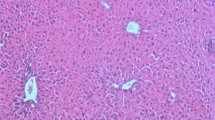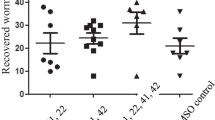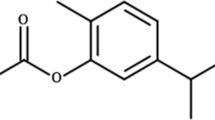Summary
Groups of six- to eight-week-old hamsters each experimentally infected with Sudanese and South African strains of S. haematobium, Puerto Rican and Liberian strains of S. mansoni, S. japonicum from mainland China, a Congo strain of S. intercalatum and a Nelspruit South African strain of S. mattheei, were treated with different dosage regimens of a new schistosomicide — praziquantel.
The drug is more effective against S. haematobium when administered by the intramuscular route than per os, a complete parasitological cure being obtained following a single intramuscular injection of 200 mg/kg bwt. Per os the best results were obtained using the three highest regimens of 5×100 mg/kg, 5×50 mg/kg and 3×100 mg/kg bwt. It was observed that S. haematobium female worms are more susceptible to the compound than male worms.
The results show that S. japonicum in the hamster is very susceptible to the compound, a dosage of 100 mg/kg administered orally for three days resulting in a complete parasitological cure. More than a 90% reduction in adult worms was obtained at all the dosage regimens used except 1×50 mg/kg (73.2%). Female worms were again found to be more susceptible to the drug than male worms. Hatching tests performed on ova in liver tissue of control and treated animals were positive up to four weeks after treatment, thus showing that praziquantel has no ovicidal properties.
Immature S. japonicum worms were found to be markedly less susceptible to treatment than the mature schistosomes (5×100 mg/kg reduced mature adults by 99.7%, but immature forms were reduced by only 54.2%).
A 100% cure rate was obtained in the hamster infected with the Liberian strain of S. mansoni following treatment with praziquantel at 3×100 mg/kg given on consecutive days, and at 3×50 mg/kg administered in one day. Treatment of the hamsters infected with the Puerto Rican strain of S. mansoni also resulted in substantial reductions of adult worms. Praziquantel was also found to be highly effective against S. intercalatum and S. mattheei.
It is noted that the efficacy of the compound against S. haematobium, S. japonicum and S. mattheei in the hamster is significantly greater than that of metrifonate (Bilarcil). Following treatment with praziquantel most S. haematobium and S. japonicum worms undergo a classic hepatic shift and are trapped and killed in the liver tissue.
It is considered that the present study shows that this new compound exhibits a high degree of activity against the three major schistosome species S. haematobium, S. japonicum and S. mansoni, against S. intercalatum, and against the cattle schistosome S. mattheei in the hamster, with no apparent significant differences in efficacy against the different geographical strains of the parasites used in the trials.
Zusammenfassung
Gruppen von 6–8 Wochen alten Goldhamstern wurden jeweils mit einem sudanesischen und südafrikanischen Stamm von S. haematobium, mit einem puertoricanischen und liberianischen Stamm von S. mansoni, mit S. japonicum aus Kontinentalchina, S. intercalatum vom Kongo und mit S. mattheei aus Nelspruit, Südafrika, infiziert und mit verschiedenen Dosierungen des neuen Schistosomenmittels Praziquantel behandelt.
Praziquantel ist gegen S. haematobium bei intramuskulärer Gabe wirksamer als bei oraler Gabe. Eine parasitologische Heilung konnte durch eine einmalige intramuskuläre Injektion von 200 mg/kg erreicht werden. Bei oraler Gabe ergaben die drei höchsten Dosen 5×100, 5×50 und 3×100 mg/kg die besten Ergebnisse. Es wurde beobachtet, daß die Weibchen von S. haematobium empfindlicher gegen Praziquantel sind als die Männchen.
Die Ergebnisse zeigen, daß S. japonicum im Goldhamster sehr empfindlich gegen Praziquantel ist. Eine parasitologische Heilung wird durch 3×100 mg/kg erreicht. Mit allen verabreichten Dosen wurde die Zahl der adulten Parasiten um mehr als 90% reduziert. Nur bei Gabe von 1×50 mg/kg betrug die Parasitenreduktion 73,2%. Wieder waren die Weibchen empfindlicher gegen Praziquantel als die Männchen. Der Miracidienschlüpfversuch wurde an Eiern aus der Leber behandelter und unbehandelter Kontrolltiere durchgeführt. Er war bis zu vier Wochen nach der Behandlung positiv; Praziquantel wirkt also nicht ovizid.
Jugendliche S. japonicum waren gegen die Behandlung deutlich unempfindlicher als adulte Schistosomen (5×100 mg/kg bewirkten bei Adulten eine Reduktion um 99,7%, bei den Jugendlichen eine um 54,2%).
Eine parasitologische Heilung wurde bei Goldhamstern, die mit einem liberianischen Stamm von S. mansoni infiziert waren, mit 100 mg/kg (verabreicht an drei aufeinanderfolgenden Tagen) und mit 3×50 mg/kg/die erreicht. Die Behandlung von Goldhamstern, die mit einem puertoricanischen S. mansoni-Stamm infiziert waren, ergab ebenfalls eine sehr starke Reduktion der Anzahl adulter Schistosomen. Gegen S. intercalatum und S. mattheei war Praziquantel ebenfalls sehr gut wirksam.
Es wurde gefunden, daß die Wirksamkeit von Praziquantel gegen S. haematobium, S. japonicum und S. mattheei im Hamster deutlich besser ist als die von Metrifonat (Bilarcil). Nach Behandlung mit Praziquantel zeigen die meisten S. haematobium- und S. japonicum-Würmer eine klassische “liver shift” und werden im Lebergewebe festgehalten und abgetötet.
Die Untersuchung zeigt, daß Praziquantel gegen alle drei wichtigen Schistosomenarten, S. haematobium, S. japonicum und S. mansoni, und auch gegen S. intercalatum sowie gegen den Rinderparasiten S. mattheei im Hamster hoch wirksam ist. Zwischen den in dieser Untersuchung verwendeten Parasitenstämmen unterschiedlicher geographischer Herkunft bestehen in der Wirksamkeit keine wesentlichen Unterschiede.
Similar content being viewed by others
References
Foster, R.: The preclinical development of oxamniquine. Rev. Inst. Med. trop. S. Paulo 15 (Supl. 1), 1–9 (1973)
Foster, R., Cheetham, B.L., Mesmer, E.T., King, D.F.: Comparative studies of the action of mirasan, lucanthone, hycanthone and niridazole against Schistosoma mansoni in mice. Ann. trop. Med. Parasit. 65, 45–58 (1971b)
Foster, R., Mesmer, E.T., Cheetham, B.L., King, D.F.: The control of immature Schistosoma mansoni in mice by UK 3883, a novel 2-aminomethyletetrahydroquinoline derivative. Ann. trop. Med. Parasit. 65, 221–232 (1971a)
Gönnert, R., Andrews, P.: Praziquantel, a new broad-spectrum antischistosomal agent. Z. Parasitenk. 52, 129–150 (1977)
Hoffman, D.B.: Schistosomiasis research — the strategic plan. New York: The Edna McConnell Clark Foundation, 1975
James, C., Webbe, G.: The susceptibility of Schistosoma japonicum in hamsters to metrifonate. Ann. trop. Med. Parasit. 68, 487 (1974)
James, C., Webbe, G., Preston, J.M.: A comparison of the susceptibility to metrifonate of Schistosoma haematobium, S. mattheei and S. mansoni in hamsters. Ann. trop. Med. Parasit. 66, 467–474 (1972)
Lämmler, G.: Die experimentelle Chemotherapie der Trematoden — Infektionen und ihre Problematik. Z. Tropenmed. Parasit. 15, 337–368 (1964)
Pellegrino, J., Lima-Costa, F.F., Carlos, M.A., Mello, R.T.: Experimental chemotherapy of schistosomiasis mansoni. XIII. Activity of praziquantel, an isoquinoline-pyrazino derivative, on mice, hamsters and Cebus monkeys. Z. Parasitenk. 52, 151–168 (1977)
Smithers, S.R., Terry, R.H.: The infection of laboratory hosts with cercariae of Schistosoma mansoni and the recovery of the adult worms. Parasitology 55, 695–700 (1965)
Webbe, G., James, C.: The importance and maintenance of schistosomes of human and veterinary importance. Ninth Symp. Brit. Soc. Parasit., pp. 77–107. Oxford: Blackwell 1971
WHO: Schistosomiasis control. Wld Hlth Org. techn. Rep. Ser. No. 515 (1973)
Wright, C.A., Southgate, V.R., Knowles, R.J.: What is Schistosoma intercalatum Fisher 1934? Trans. roy. Soc. Med. Hyg. 66, 28–64 (1972)
Author information
Authors and Affiliations
Rights and permissions
About this article
Cite this article
Webbe, G., James, C. A comparison of the susceptibility to praziquantel of Schistosoma haematobium, S. japonicum, S. mansoni, S. intercalatum and S. mattheei in hamsters. Z. F. Parasitenkunde 52, 169–177 (1977). https://doi.org/10.1007/BF00389901
Received:
Issue Date:
DOI: https://doi.org/10.1007/BF00389901




